What causes breast pain on both sides?

|
There are many reasons for breast pain on both sides. For adolescent girls, their breasts are still developing and may cause mild swelling and pain. For mature women, the swelling and pain may be related to mastitis or breast nodules, which may cause swelling and pain on both sides of the breasts. This situation may also occur in early pregnancy. What causes breast pain on both sides? 1. Breast pain during adolescence: Girls between 9 and 13 years old begin to develop breasts, and dome-shaped nodules the size of peas or beans appear in the breast tissue under the nipple, with slight pain. After menarche, it will disappear on its own as the breasts mature during puberty. 2. Breast tenderness during menstruation: It is the most common type of breast pain, accounting for about 65% of all breast pain, and the average age of occurrence is 35 years old. The pain usually occurs or worsens 3 to 7 days before menstruation and gradually disappears or eases after menstruation. The severity of the pain varies from month to month, and is often felt as a heaviness, distension, dull pain, or occasional brief tingling sensation. There are also tender breast nodules, which are aggravated by pressure, movement or lifting objects. 3. Breast pain during pregnancy: Some expectant mothers experience breast pain around 40 days after pregnancy due to the placenta and villi secreting large amounts of estrogen and progesterone, which enlarges the breasts. In severe cases, the pain may last throughout the pregnancy and usually does not require treatment. Breast cancer can cause pain on both sides of the breast Breast pain is one of the most important manifestations of breast cancer. Clinically, it is believed that if the breast pain is unbearable, it is usually in the late stage of breast cancer. It is reported that only 6% of breast cancer patients feel breast pain in the early stages. Breast cancer is a disease that is common among women aged 20 to 40, so it must be taken seriously by female friends. What are the other causes of breast pain? Breast pain is a common complaint in outpatient clinics. Breast pain can be divided into cyclical and non-cyclical types, and can also change from cyclical to non-cyclical. 2/3 of breast pain is cyclical. The vast majority of patients are premenopausal women. The most common site of pain is above the outer side of the breast, and symptoms worsen before menstruation. The pain is characterized by distension, heaviness and tenderness. 1. Breast pain caused by reasons other than the breast: In fact, it is diseases in other parts of the body that manifest as breast pain, such as pneumonia and costochondritis. 2. Cyclic breast pain: It is related to the menstrual cycle and reflects the cyclical changes in hormones in the body. This pain is normal to a large extent, mainly occurs in premenopausal women, especially before the age of 35, and most of them can be relieved by themselves. 3. Non-cyclical breast pain: Compared with cyclical breast pain, non-cyclical breast pain is more worthy of attention. But most non-cyclical breast pain is also benign. Its characteristics include intermittent onset, variable pain intensity, mostly unilateral occurrence, and sharp nature. |
<<: What diseases does the liver usually have?
>>: How does Traditional Chinese Medicine explain polycystic ovary?
Recommend
Causes of hair loss in women over 30
Women in their 30s are also prone to hair loss, a...
What psychological secrets does rubbing your hands imply?
When a child sees his mother pushing a cart of gr...
Does eating durian in late pregnancy help the fetus?
Durian is a tropical fruit that we often eat. It ...
What are the characteristics of TCM health preservation?
Health preservation is something that many of our...
Symptoms of premature ovarian failure, these four points are the most obvious
Premature ovarian failure is very harmful to the ...
What to do if you feel dizzy and weak
What should I do if I feel dizzy and weak? Dizzin...
How serious is the high T3T4 of hyperthyroidism?
How serious is the high T3T4 of hyperthyroidism? ...
Cauliflower-shaped vagina
For women, the vagina is a very private place. Bu...
There are two horizontal lines on my neck. What's going on?
Horizontal lines on the neck are called neck wrin...
What are the functions and effects of enzymes?
Enzyme is a very hot substance at the moment. Gen...
Are varicose veins on the temples serious?
Varicose veins in the temples are also quite comm...
The efficacy of stewed duck with Ganoderma lucidum
The medicinal value of stewed duck with Ganoderma...
Is toothpaste alkaline?
Generally speaking, toothpaste is basically weakl...
Who should not eat loquat leaves?
Loquat leaves are relatively common plants in our...
The efficacy and function of steamed Schisandra chinensis
Schisandra is a common Chinese herbal medicine. W...









